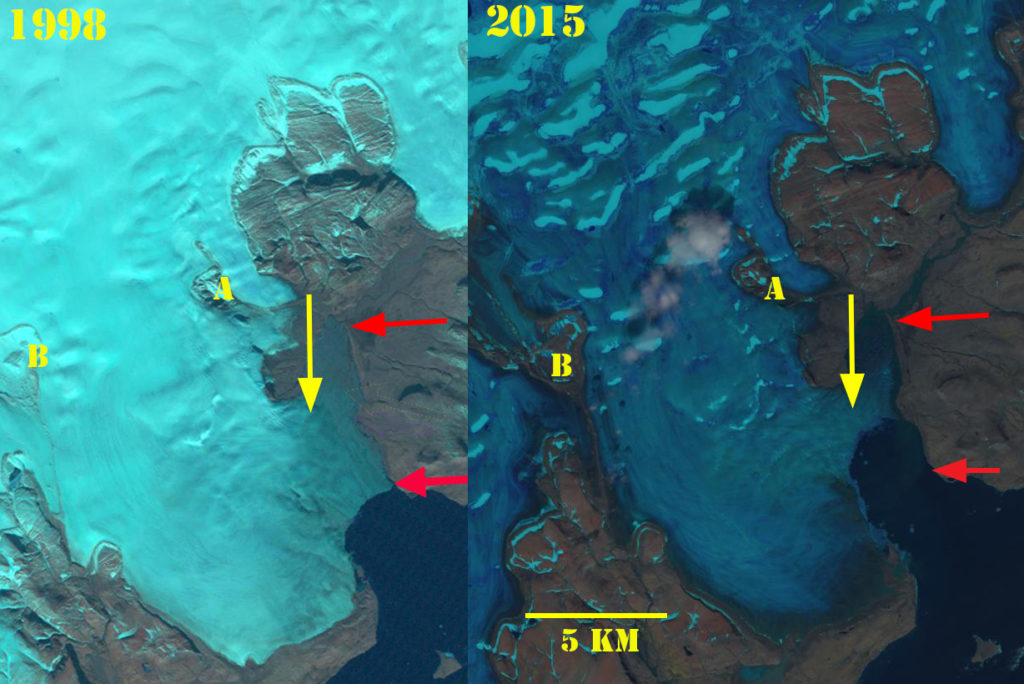November 23, 2019
Kropotkina, Novaya Zemlya Retreat Opens 12 km2 Embayment 1988-2019
Posted by Mauri Pelto
Kropotkina Glacier, Novaya Zemlya in 1988 and 2019 Landsat images. Red arrow marks the 1988 terminus location and yellow arrow the 2019 terminus location. Point A and B mark nunataks in 1988.
Kropotkina Glacier is a tidewater glacier on the southeast coast of Novaya Zemlya that drain into Vlaseva Bay. The glaciers terminate in the Kara Sea and has been retreating like all tidewater glaciers in Novaya Zemlya LEGOS, 2006 . The map shown below from this project indicates the lack of an embayment in 1952, red dashed line and limited retreat from 1952-1988. Carr et al (2014) identified an average retreat rate of 52 meters/year for tidewater glaciers on Novaya Zemlya from 1992 to 2010 and 5 meters/year for land terminating glaciers. Carr et al (2017) found that between 2000 and 2013, retreat rates were significantly higher on marine-terminating outlet glaciers than during the previous 27 years. Here we examine Landsat imagery from 1988 to 2019 to identify changes in Kropotkina Glacier.
In 1988 the southern terminus is at the red arrow indicating a peninsula on the east side of the terminus, while the northern terminus is at the margin of a proglacial lake. Point A and B are nunataks. In 1998 the southern terminus has not changed significantly. The northern terminus has not retreated significantly, but the proglacial lake has drained. By 2015 the terminus tongue in the embayment has largely collapsed, though a tongue of ice reaches across this embayment. An area of more 7 km2 has gone from glacier ice to embayment since 1998. Point A is no longer a nunatak as marginal retreat has reached this point. The snowline in 2015 is also higher than is typically observed extending beyond the image area and is above 800 m.
By 2019 the main embayment is free of ice, having expanded by 12 km2, as the result of terminus retreat. The terminus is now oriented north-south with a 6 km long calving front. The 2019 snowline is at 750 m.Point B remains a nunatak, but not for long with the continued high snowlines seen in 2015, 2018 and 2019. The retreat has mainly been via calving, and with an expanding calving front and reduced pinning points along the margin, the rapid retreat and area loss is not over. How deep the water is at the calving front will determine how limited calving will be going forward. The retreat of this glacier is substantial as has been the norm for tidewater glaciers such as Inostrantseva Glacier, Vera Glacier, Mack and Velkena Glacier or Chernysheva Glacier, with the formation of new islands and glacier separation common place Pelto (2017) and GlacierHub.
Kropotkina Glacier, Novaya Zemlya in 1998 and 2015 Landsat images. Red arrow marks the 1988 terminus location and yellow arrow the 2019 terminus location. Point A and B mark nunataks in 1988.
Map of the region from LEGOS, 2006 with elevations indicated.





 Dean of Academic Affairs at Nichols College and Professor of Environmental Science at Nichols College in Massachusetts since 1989. Glaciologist directing the North Cascade Glacier Climate Project since 1984. This project monitors the mass balance and behavior of more glaciers than any other in North America.
Dean of Academic Affairs at Nichols College and Professor of Environmental Science at Nichols College in Massachusetts since 1989. Glaciologist directing the North Cascade Glacier Climate Project since 1984. This project monitors the mass balance and behavior of more glaciers than any other in North America.
[…] Fonte/Source: https://blogs.agu.org/fromaglaciersperspective/2019/11/23/kropotkina-novaya-zemlya-retreat-opens-up-… […]